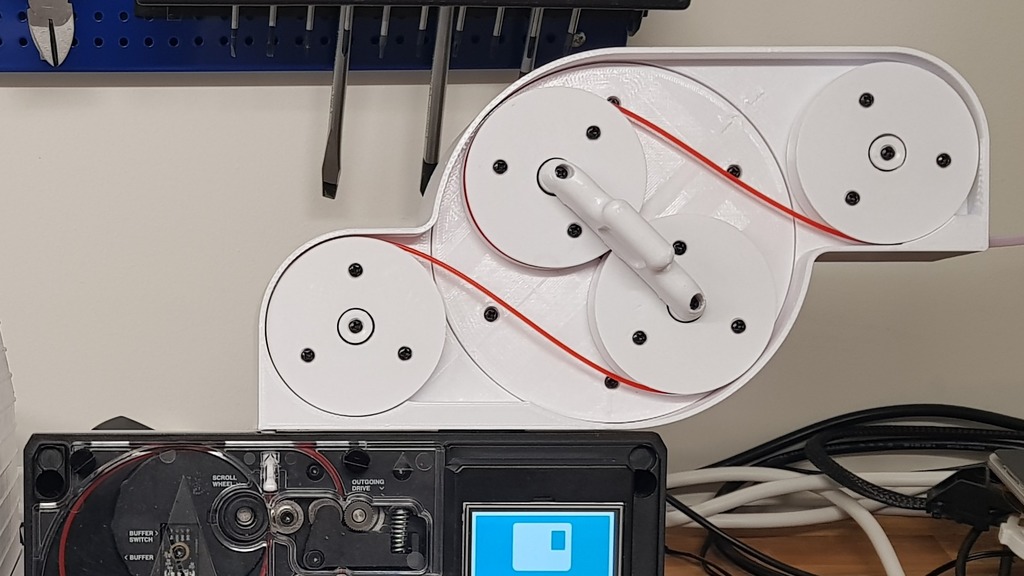
External buffer for Mosaic Palette 2
thingiverse
This is an external filament buffer designed for use with the Mosaic Palette 2 and Palette 2 Pro. IMPORTANT! Version 7.0.6 of the Palette 2 firmware introduced jam and run-out detection, which makes it incompatible with this buffer since it will trigger false errors that will make the Palette cancel the print. When I informed them about this issue, they kindly agreed to add an option for disabling this feature in version 7.2.6. Please look at the bottom of this description for instructions on how to do this. The internal buffer in the Palette 2 multi-material splicer is too small to fully utilize the splicing capability of the machine. Due to other unfortunate design decisions made for the entire buffer system, the machine cannot even fully utilize the tiny buffer that it has. Most objects have an uneven division between the up to four materials being used per layer. It's essential that the buffer is large enough to average out the load on the splicer over the whole layer, something the undersized buffer of the Palette 2 fails to do. Be aware that using this buffer can cause calibration problems. The Palette tracks the progress of the printer and compares it to how much filament has been pulled out of the Palette. It then continuously adjusts the splice lengths to compensate for variations in the printer's consumption (due to extruder slippage or other anomalies). It does this by inserting instructions in the gcode to make the Octoprint server that feeds the printer ping the Palette. When it receives such a ping, it assumes its position and calibrates accordingly. The problem with the buffer is that if it's deeply depleted when a ping is being sent, the printer has used a lot of filament that hasn't yet been accounted for by the Palette's scroll wheel. For me, it seems to perform very well up to at least ~100mm/s. Then, it only briefly depletes the internal buffer, and it doesn't have a high risk of having a ping fire while it is being depleted. If it's unlucky with a ping, the offset will not be very large. I've also succeeded in printing at 200mm/S, but that's really pushing it. It won't starve the printer at such a speed, but I expect calibration issues. I have a couple of ideas on how the firmware could be changed to avoid calibration problems. If the printer would ping much more frequently (so missing some wouldn't be a big deal) and the Palette would ignore any pings it receives while its buffer-empty switch is being pressed, I believe that should solve the issue. This buffer requires an appropriate spring. The spring I used has a 40mm x 7mm coil (when relaxed) and the wire is 0.7mm in diameter. A 4mm OD PTFE tube between the output of the buffer and your printer is also required. Here's a video I made before being 100% done with the design of the V2, talking about the new features of V2 compared to V1: https://youtu.be/AliUjdSXp_g How to disable run-out detection: Like mentioned above, the run-out detection in newer firmwares is incompatible with this buffer. But in 7.2.6, they added the option for disabling it when using the buffer. I haven't had time to test this myself yet, so I'm still running 6.1.5 and as such has not yet tested the instructions I got from Mosaic on how to disabled it. Unfortunately, there is no regular preference option to do this, and you have to connect it to a PC via USB and connect to it using a terminal program. They mention that you can use the Arduino IDE, but most terminal programs should work. I'm planning to test with Putty first or maybe a terminal program running on the RPi so I don't have to connect it to the PC at all. Here are the instructions I got from Mosaic: 1. The first thing to do is to connect to your Palette over serial. You can do this by using the Arduino IDE and connecting the Palette via USB to your PC. With it connected, please set up the baudrate to 115200 and newlines to be enabled. 2. Send command "070 DB8 D1" 3. Send "070 DB8" to verify that the command was successful; you should receive "070 DB8 D1" if it was. I also asked how to set it back to default, and that can be done by sending the command "070 DB8 D0".
With this file you will be able to print External buffer for Mosaic Palette 2 with your 3D printer. Click on the button and save the file on your computer to work, edit or customize your design. You can also find more 3D designs for printers on External buffer for Mosaic Palette 2.
